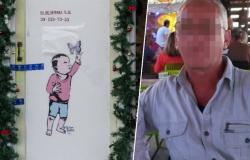The title of Paolo Cognetti’s new book, Down in the valleyseems like a statement: the successful writer of, among others The eight mountains and The wolf’s happiness doesn’t want to be labeled as a writer of novels set in the mountains. Down in the valley It starts promisingly with the story about a small white bitch who is taken in tow by a large gray male who kills dogs through the valley. The residents ask whether it is a wolf or a ‘mixture’ of dog and wolf. The hunters gather at night, even though they know the wolf is protected. It’s Cognetti at his best; you see the bitch, you hear the excavator and feel the threat of the unknown dog.
The story of the fighting dogs is a story in itself. The actual plot lies with the two brothers Alfredo (35) and Luigi (37) and his wife Elisabetta. The brothers’ father has died and his house at an altitude of 1800 meters in Fontana Fredda has become available. Next to the house, the father planted a larch at the birth of the eldest brother, Luigi, and a spruce at the birth of Alfredo. The larch is strong, slender and proudly reaches for the light, the fir, on the other hand, retains its dark needles, is overshadowed by the larch and does not make it to the sky. The extremes of light and dark of the birth trees symbolize not only the characters of the brothers, but also the valley where the story takes place, which is half in the sun and half in the shade.
Cognetti chose one of the valleys he knew from his youth. ‘The Valsesia’ is the darkest, it rains constantly and there is a lot of drinking (‘There were more cafes than people, at four o’clock in the afternoon already with their elbows on the bar’). Higher up in the valley, on the way to Fontana Fredda, you see the snow on the slope of Monte Rosa, the harsh light of which hurts your eyes.
Luigi is a good police officer at the Forestry Commission (‘Collecting dead dogs and traffic control’) and wants to live in the parental home with Elisabetta and for this his brother Alfredo must be bought out. They last saw each other seven years ago. Alfredo is the wilder of the two – he fled the valley and sought refuge in Canada. How the brothers relate to each other and their past is developed in an inventive way: after two chapters about the brothers, Alfredo is given the floor and the novel switches to the first person. The same applies to Luigi, who is allowed to tell his side of the story in the first person in the next chapter. They show their feelings and talk about their father’s house.
In between, it is the turn of the Milanese Elisabetta, who spent summers in the Valsesia with her parents as a teenager, fell in love with Luigi and followed him. Unfortunately, it is not written from the first person, like the chapters about the brothers, but Cognetti writes about her.
I praised The wolf’s happiness even more so because Cognetti so clearly showed the down-to-earth voice of the woman with Babette and Silvia, but now, as far as Elisabetta is concerned, it is full of corny sentences such as ‘Elisabetta is a woman who has loved the company of writers and writers since childhood. writers as in that of people of flesh and blood: she talks to them and they talk back’.
Hunters and drunken men
Precisely because both brothers show the backs of their tongues, you expect much more empathy in the chapter about Elisabetta. What does she really think about the hunters and the men who are drunk for days on end? According to Cognetti, Elisabetta ‘never wasted time in regrets’ because ‘the river only flows one way’. And the fact that a novel character looks at herself in the mirror and thinks she “looks a little unkempt” seems more like the look of a man than the thought of a woman. Where has the woman’s voice gone?
The last chapter consists of a poem, a pamphlet in stanzas of four lines against the commercialization of the mountain at the expense of nature. There will be a slope and a ski lift covering ten hectares of forest with five thousand trees. The trees form an army on the battlefield Fontana Fredda: ‘Rough and fierce the spruce,/ ruthless the ash:/ it does not attack sideways,/ but aims straight at the heart. […] ‘The larch cried out: / heaven and earth trembled. / Branches with young shoots / dug into the ground.’ Here Cognetti shows his commitment to the climate and the will to protect the mountains against the arrival of even more ski lifts.
That’s it Down in the valley a mediocre novel about the people in the valley and dogs in the valley with somewhat interconnected stories with recurring themes that we know from The eight mountains and The wolf’s happiness. In the first book, two friends build a house on a piece of land left by the father of one of them. In Down in the valley they are two brothers who rather ‘fight’ over the father’s house. In The wolf’s happiness the return of the wolf already passed and the women from the big city were introduced.
Bruce Springsteen
But then something unexpected happens; In an afterword, Cognetti explains how the novel came about, giving you a new view of the story. He listened to the album countless times as a teenager Nebraska by Bruce Springsteen. In a long exposé he reviews that album Down in the valley seems like a kind of tribute to the singer. You understand the rawness of the environment, you understand the attitude of the brothers. Not only the first song ‘Nebraska’ is included in the book – songs such as ‘My fathers house (I was dreaming)’ and ‘Nothing feels better than blood on blood Brother Frenkie’ are also reflected. At Cognetti, it is Alfredo who asks his brother for a hug.
Cognetti also refers to the stories of writers such as Raymond Carver, Flannery O’Connor and Karen Blixen. He explains why he chose the valley ‘where the bad weather comes from’ of his youth for ‘his Nebraska’. Finally, the poem about the trees going to war turns out to be based on Cad Goddeu: the medieval poem The battle of the trees, written by the Celtic Taliesin. Cognetti rewrites it ‘mindful of the trees of his forests’ and turns it into a beautiful and menacing poem.
But a novel that has to be explained afterwards, even though it still contains such beautiful moments, is not in its strength. Perhaps the afterword as a foreword would have had more meaning for the reader.
To share
Email the editor






